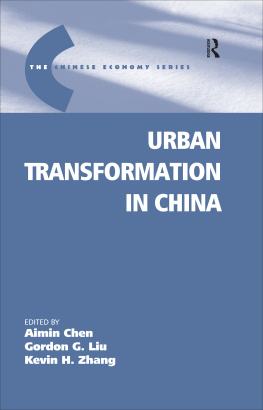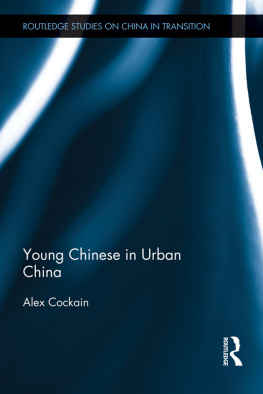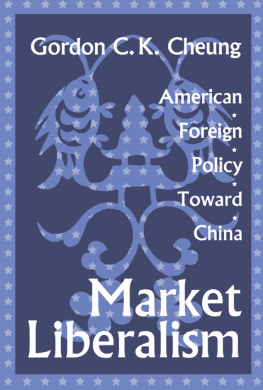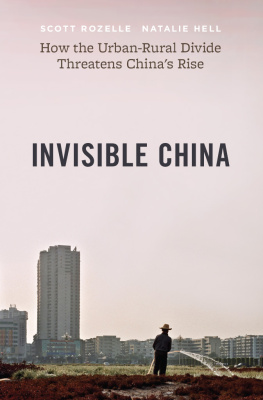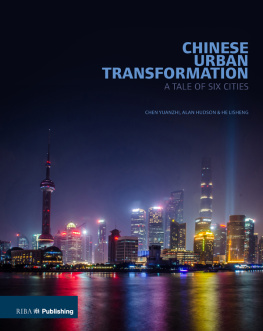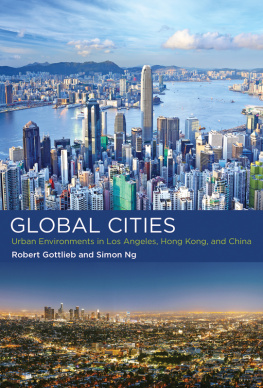First published 2004 by Ashgate Publishing
Published 2016 by Routledge
2 Park Square, Milton Park, Abingdon, Oxon OX14 4RN
711 Third Avenue, New York, NY 10017, USA
Routledge is an imprint of the Taylor & Francis Group, an informa business
Copyright Aimin Chen, Gordon G. Liu and Kevin H. Zhang 2004
Aimin Chen, Gordon G. Liu and Kevin H. Zhang have asserted their right under the Copyright, Designs and Patents Act, 1988, to be identified as the editors of this work.
All rights reserved. No part of this book may be reprinted or reproduced or utilised in any form or by any electronic, mechanical, or other means, now known or hereafter invented, including photocopying and recording, or in any information storage or retrieval system, without permission in writing from the publishers.
Notice:
Product or corporate names may be trademarks or registered trademarks, and are used only for identification and explanation without intent to infringe.
British Library Cataloguing in Publication Data
Urban transformation in China. - (The Chinese economy series)
1. Urbanization - China 2. Cities and towns - China - Growth
3. China - Economic conditions - 1949- 4. China - Social conditions - 1949-
I. Chen, Aimin II. Liu, Gordon G. III. Zhang, Kevin H.
307.7'6'0951
Library of Congress Cataloging-in-Publication Data
Urban transformation in China / edited by Aimin Chen, Gordon G. Liu and Kevin H. Zhang.
p. cm. - (The Chinese economy series)
Includes bibliographical references and index.
ISBN 0-7546-3312-8
1. Cities and towns-China. 2. Urbanization-China. I. Chen, Aimin. II. Liu, Gordon G.
III. Zhang, Kevin H. IV. Series.
HT147.C48U723 2004
307.76'0951-dc22
2003056778
Transfered to Digital Printing in 2010
ISBN 9780754633129 (hbk)
ISBN 9781138277564 (pbk)
CONTENTS
Aimin Chen, Gordon G. Liu and Kevin H. Zhang
D. Gale Johnson
Kevin H. Zhang
Yi Feng and Siddharth Swaminathan
Qi Hong Dong
Aimin Chen and N. Edward Coulson
Jeff Kejing Xie and Kevin Honglin Zhang
Daniel Goodkind and Loraine A. West
Fei-Ling Wang
Shunfeng Song and Kevin H. Zhang
Mei Wen
Xiaobo Zhang
Shuanglin Lin and Shunfeng Song
Zuohong Pan and Fan Zhang
Zhigang Tao and Y.C. Richard Wong
Hanchao Lu
About the Editors
D. GALE JOHNSON
The University of Chicago
The further urbanization of China will present the citizens and policy makers of China with major political, social and economic issues over the next several decades. The process of rapid urbanization through the influx of rural people into cities has never been without turmoil anywhere in the world. But in the case of China the controls that have been maintained on rural to urban migration which have resulted in a very large income disparity may well present even greater difficulties than found elsewhere. For the past four decades China has attempted to control the degree of urbanization through the hukou system which was designed to limit rural to urban migration as well as migration in urban areas. This system is being relaxed and there has been increased migration in recent years. Thus it was very appropriate that the theme of the conference should be the urban transformation in China.
China has a smaller percentage of its population living in urban areas than would be expected for an economy at its level of income. This has occurred as a result of its deliberate policy of limiting the migration that normally occurs during a long period of economic development during which employment in agriculture declines from being the source of employment of the majority of the labor force to having a relatively small minority of the labor force so engaged. According to the 2000 Census, the urban population of China was 36.2 per cent of the total population. This represented a significant increase from the estimate of 30.9 per cent for 1999. The increase was apparently due to two factors. First, due to population growth certain communities that were classified as rural during the 1990s were now classified as urban, and, second, the definition of a permanent resident was changed by reducing the number of months an individual was required to have lived in a community to be counted in the place of residence. Prior to the 2000 Census an individual had to reside in an area for a year to be counted as a resident; in the 2000 Census that period was reduced to six months. So far as I know, it has not been indicated how much of the 69.5 million increase in the urban population between the end of 1999 and 1 November 2000 was due to these two factors. Some small part of the increase was due to natural growth of the population.
While to some degree the content of nearly every chapter in this volume has been affected by the hukou system of controlling migration, I want to draw special attention to two of them. The chapter by Fei-Ling Wang Hukou Systems and Migration Controls is the best discussion of the system that I have ever seen. It provides a remarkable amount of detail of how the system is administered and how it is used to discriminate against the rural to urban migrants. It is noted that during the period grain was both highly subsidized and rationed in urban areas, the migrants were not given access to the low cost supplies but had to purchase their grain in the market at much higher prices. After noting that the urban migrants with rural hukous had to pay for their childrens education, Wang noted that when such children were ready for college they had to return to the location of their hukou to take the entrance examinations. Why was this important? Wang notes: To many the regional differential in college entrance examinations and admissions remains perhaps the most important state subsidy to selected urban populations especially in major metropolitan areas such as Beijing and Shanghai. Why is this a subsidy? Because the required scores for admission to college are lower for the residents of Beijing and Shanghai to attend colleges in those cities than for, say, the residents of Sichuan or Guizhou. Actually this form of discrimination is principally discrimination against rural residents since a student with a hukou in Chengdu can be admitted to a college in Chengdu with a lower score than a student from a village in Sichuan.
In Daniel Goodkind and Loraine A. West summarize the available and often confusing evidence on the size of the floating population primarily those living in urban areas but without an urban hukou. They find that studies define the floating population in different ways. They note a special study for 1999 in which the floating population was defined as being away from the residence of their hukou for six months or longer and found that 63.8 million people were involved. In their chapter they note a recent change with respect to the education of children of temporary migrants, which are all those people who do not have a hukou in the city in which they reside regardless of how long they may have lived there. Cities are now required to provide schooling for children of migrants who have lived in the city for six months or more. However, the migrant children go to special schools, not the regular urban schools.

